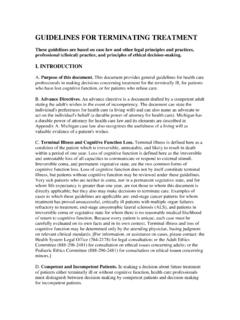Transcription of BEHAVIOR CONTRACTS - Medical Protective
1 BEHAVIOR CONTRACTS . Medical Protective Clinical Risk Management Department OCTOBER 2013. For questions, products, or services, please contact 800 4 MEDPRO or visit This document should not be construed as Medical or legal advice. Since the facts applicable to your situation may vary, or the laws applicable in your jurisdiction may differ, please contact your attorney if you have any questions related to your legal obligations or rights, application of state or federal laws, contract interpretation, or other legal questions that may potentially impact the applicability of the information provided in this document.. The Medical Protective Company. 2013. All rights reserved. CONTENTS. INTRODUCTION .. 2. OBJECTIVES .. 2. QUESTIONS TO CONSIDER BEFORE USING A BEHAVIOR contract .. 2. DEVELOPING A BEHAVIOR contract .. 3. PRESENTING THE contract TO THE PATIENT.
2 4. Patient Rejection of the contract .. 4. Patient Noncompliance With the contract .. 5. FAMILIES/SIGNIFICANT OTHERS .. 5. PAIN MANAGEMENT CONTRACTS .. 5. Other Pain Management Considerations .. 6. FINANCIAL CONTRACTS .. 6. SAFETY .. 7. CONCLUSION .. 7. RESOURCES .. 8. APPENDIX A. SAMPLE COVER LETTER FOR BEHAVIOR 9. APPENDIX B. SAMPLE PATIENT/FAMILY BEHAVIOR contract .. 10. Guideline: BEHAVIOR CONTRACTS 2. INTRODUCTION. Healthcare providers can use BEHAVIOR CONTRACTS to address problematic patient behaviors in an effort to preserve the provider patient relationship. BEHAVIOR CONTRACTS also can be used to support the process of terminating the provider patient relationship. Using a BEHAVIOR contract might be beneficial when working with patients who have: Drug seeking or addictive behaviors;. Patterns of inappropriate BEHAVIOR ( , verbal, physical, etc.)
3 ;. Manipulative BEHAVIOR ;. Continued noncompliance issues ( , repeated no shows; agreeing to, but not complying with, a treatment plan; etc.); or Financial barriers. What may seem like common sense BEHAVIOR to a healthcare provider may not align with what the patient has learned over his or her lifetime. The provider's role includes setting rules and expectations for an effective relationship. BEHAVIOR CONTRACTS are a tool that helps facilitate this process. OBJECTIVES. The objectives of this guideline are to: Provide guidance on when and with whom to use BEHAVIOR CONTRACTS ;. Describe essential components of BEHAVIOR CONTRACTS and how to develop and present these CONTRACTS ;. Review other considerations related to BEHAVIOR CONTRACTS , such as family involvement and safety; and Discuss specifics related to pain management and financial CONTRACTS .
4 QUESTIONS TO CONSIDER BEFORE USING A BEHAVIOR contract . Before attempting to implement a BEHAVIOR contract with a patient, consider the following questions: Is the relationship worth preserving? Is the patient acutely ill? Is the BEHAVIOR ongoing, or was it an isolated incident? Can the problematic BEHAVIOR (s) be changed? Guideline: BEHAVIOR CONTRACTS 3. Is the person who has the problematic BEHAVIOR the patient or a family member/significant other? Do certain factors such as intellectual immaturity, health illiteracy, or co- morbidity inhibit the patient from understanding that the BEHAVIOR is hindering an effective relationship? What measures have been taken so far to correct the BEHAVIOR ? Is the problematic BEHAVIOR objectively documented in the patient's Medical record as it occurs? Does the documentation avoid disparaging remarks and subjective statements?
5 Are quotes used when possible? Are you willing to follow through with the terms of the contract if it is violated ( , terminate the relationship)? Has a threat of harm or actual harm occurred to you or your staff? If yes, implementing a BEHAVIOR contract may not be appropriate. You may want to consider terminating the provider patient relationship. DEVELOPING A BEHAVIOR contract . All BEHAVIOR CONTRACTS should include basic elements, such as: The contractual parties ( , patient, provider/staff, guarantor, family members, etc.);. The behaviors you expect from the patient, as well as BEHAVIOR they can expect from you and your staff;. The consequences of violating the contract terms; and The signatures of those entering into the contract . In addition to including basic elements, providers should ensure that BEHAVIOR CONTRACTS are customized to each patient's individual needs.
6 Further, BEHAVIOR expectations should be scripted as positive behavioral goals, rather than just addressing negative behaviors to avoid. For example: I will treat staff with respect and dignity whether in the clinic or on the phone. I will use a normal tone of speech when speaking with staff. I will comply with my treatment plan and recommendations. Make the behavioral goals broad enough to address several issues. You can add specifics by offering examples. For instance, I will comply with the clinic's policies and procedures. For example, I will contact the clinic 24 hours in advance if I am unable to keep my appointment.. Focus on the most problematic behaviors, and limit the number of expectations to avoid overwhelming the patient. So, for example, if your patient continuously uses foul Guideline: BEHAVIOR CONTRACTS 4. language on the phone and in front of other patients, consider blending the two issues into one expectation I will use appropriate language when speaking in the clinic or on the phone.
7 In some cases, you may want to consider working with the patient to develop the behavioral expectations. By doing so, you may increase the likelihood that the patient will comply. For information specific to financial and pain management CONTRACTS , see pages 5 7. PRESENTING THE contract TO THE PATIENT. Presenting a BEHAVIOR contract is never easy. Make sure your staff is prepared for the process. Patients may react differently to the BEHAVIOR contract . For some, it might be a wakeup call, and they will accept it with understanding. For others, their behaviors may worsen. Providers and staff should be knowledgeable about the procedures for handling hostile and aggressive patients and visitors. Prior to presenting the contract , determine what you are going to say to the patient. Role playing can be an effective way to practice presenting BEHAVIOR CONTRACTS and to test procedures for handling hostile BEHAVIOR .
8 When discussing a BEHAVIOR contract with a patient, it's important to be firm, yet appropriately compassionate. Emphasize the concept that patient care is a team effort, and make it personal by highlighting the team members yourself, the patient, your staff, etc. Explain to the patient that all team members must work together effectively to preserve the provider patient relationship. Also, let the patient know what effect his or her negative behaviors are having on your ability to properly manage the patient's care. Consider sending the contract with a cover letter (see Appendix A) to the patient before his or her next appointment. This gives the patient and his or her family time to absorb the concept. See Appendices A and B for a sample cover letter and BEHAVIOR contract . Patient Rejection of the contract Upon presentation of the contract , some patients may choose to find another healthcare provider.
9 In this situation, confirm your understanding that they are choosing to take their care elsewhere by sending them a certified letter with return receipt requested. For additional information, request a copy of Medical Protective 's Terminating a Provider Patient Relationship guideline. Guideline: BEHAVIOR CONTRACTS 5. Patient Noncompliance With the contract Some patients may initially agree to the contract , but then not follow through on the terms. It can be difficult to terminate noncompliant patients who apologize or promise to abide by the contract going forward. However, if you continue to allow the BEHAVIOR after the patient agrees to the terms of the contract , the contract becomes meaningless. When behaviors constitute a breach of contract , it is better to terminate the relationship than continue the repetitive cycle of noncompliance.
10 FAMILIES/SIGNIFICANT OTHERS. On occasion, the patient is not the problem. From time to time, a well-intentioned family member or significant other might cause discord within the healthcare team. If this happens: Discuss your concerns with the patient. Share your policy as it relates to disruptive BEHAVIOR with the patient and the disruptive person. Inform the disruptive person that if the BEHAVIOR continues, he or she will no longer be able to participate in the patient provider team. PAIN MANAGEMENT CONTRACTS . Patients requiring pain medication as part of their treatment present another layer of complexity when trying to address behavioral issues. Keeping pain issues separate from behavioral issues is important, and it may require you to have two CONTRACTS . Pain CONTRACTS should be specific and directly related to the patient's pain management plan/program.








